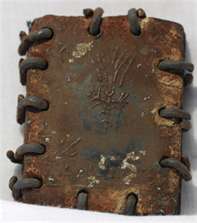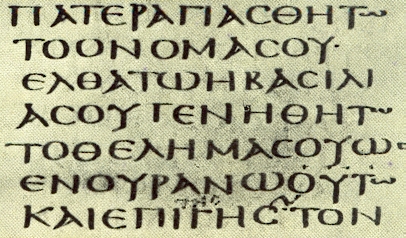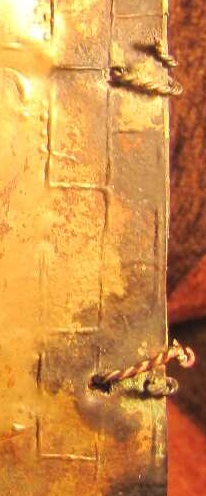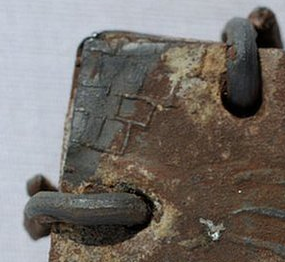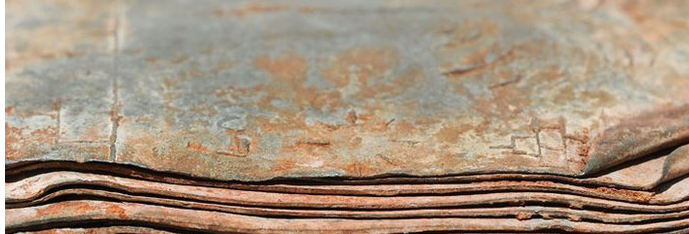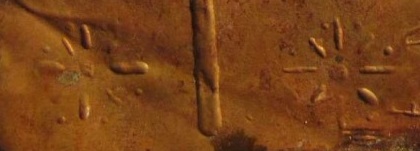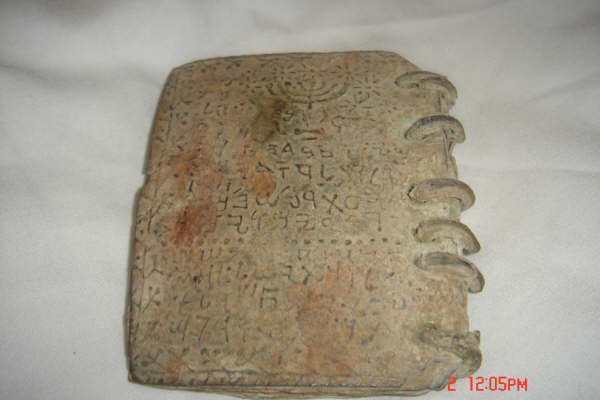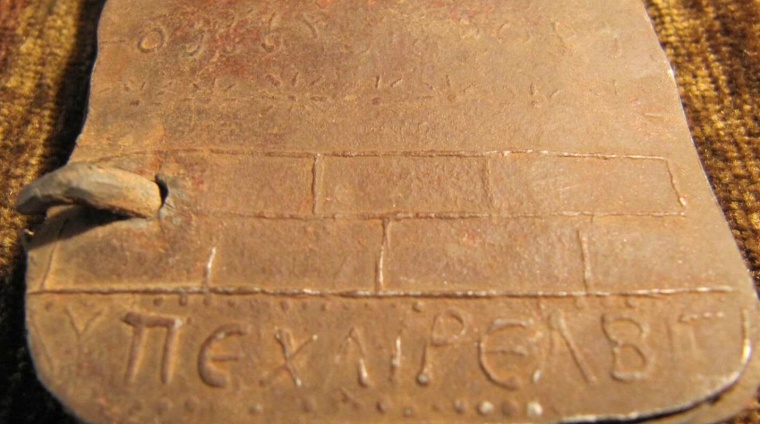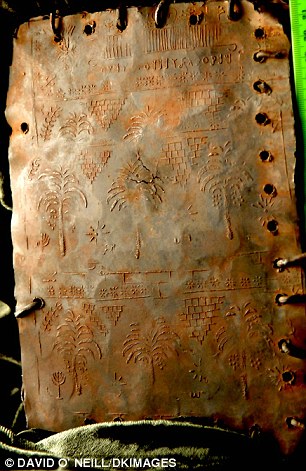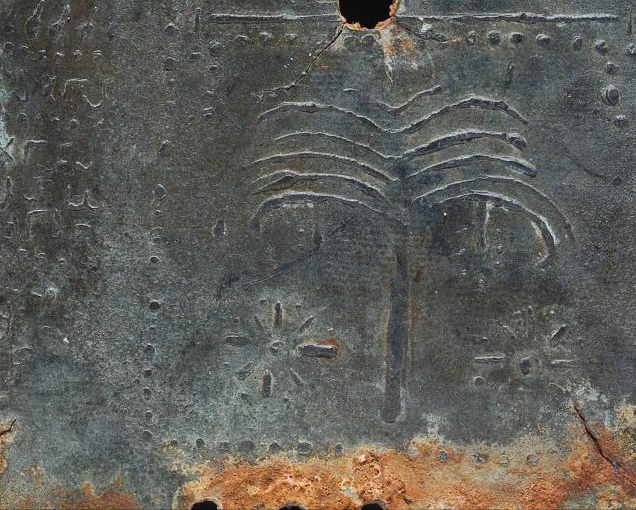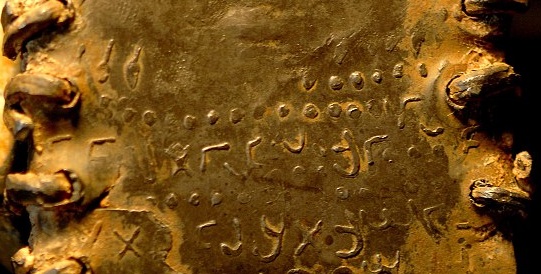Jordan Codices
This is ian earlier page from a previous release of information:
FROM 4-30-11
PUNNETT ELKIINGTON HOUR 2 AUDIO
PUNNETT ELKINGTON HOUR 3 AUDIO
PUNNETT ELKINGTON HOUR 4 AUDIO
PU
| 04-30-11 | |
| Host: | Ian Punnett |
| Guests: | David Elkington, Robert Merritt |
Joining Ian Punnett, Egyptologist and author David Elkington talked about the Jordan Codices -- ancient metal religious texts that could change the way we view Christianity and the Bible. The books are made entirely of lead and written in a form of ancient Hebrew (Hasmonean) that dates back to the 1st century BC, he explained. Within the metallic pages are numerous Messianic symbols, Temple representations, and even portraits of a person resembling Jesus, Elkington said. "It confirms the underlying story in the gospels, and confirms for the first time that Christ not only existed, but he was truly a king of Israel," he declared.
Some scholars have called into question the authenticity and age of the codices. According to Elkington, results from a series of chemical, spectagraphic, crystallographic, and corrosion tests strongly support a 1st century dating of the metal. The letters themselves have been molded with the lead and are also corroded, he noted. It is nearly impossible to artificially corrode lead, Elkington continued, pointing out that no scholars have thus far been able to answer how it could have been done. In addition, the ancient language used in the metal books is only known by a handful of experts, he said. Elkington also spoke about the area where the codices were found, speculated about the people who wrote them, and revealed some more details about their contents.
The Jordan Lead Codices, (sometimes called simply the Jordanian Codices), are a collection of codices said to have been found in a cave in Jordan and first publicized in March 2011
On 3 March 2011 the Jewish Chronicle ran an article interviewing a metallurgist named Robert Feather, who it stated was trying to authenticate a collection of 20 metal books which, it said, could be linked to the Kabbalah and were in the possession of an Israeli Bedouin farmer named Hassan Saeda, who claimed that they had been found by his great-grandfather in a cave a century ago. It added that a piece of leather from the find had already been carbon dated to 2,000 years ago. The article reported that the Israel Antiquities Authority (IAA) "absolutely doubted their authenticity," saying the books are a "mixture of incompatible periods and styles without any connection or logic. Such forged motifs can be found in their thousands in the antiquities markets of Jordan and elsewhere in the Middle East". It added that Professor André Lemaire, an epigraphist and director of studies at the École pratique des hautes études, said the inscriptions he has seen make no sense and that it was "a question apparently of sophisticated fakes".[1]
On 22 March 2011 David Elkington issued a press release stating that a hoard of ancient books made of lead and copper, together with other artefacts, probably dating from the 1st century AD, had been found in Jordan, and that they might predate the writings of St. Paul and that "leading academics" believed they might be as important as the Dead Sea Scrolls.[2] Elkington also stated that the items were discovered 5 years ago in a cave by a Jordanian Bedouin and smuggled into Israel, where they were at risk of sale on the black market or destruction.[2] The story was quickly picked up by the BBC, the Daily Mail and other media outlets.
Elkington stated that the find was of "up to 70 ring-bound books (codices) made of lead and copper. Many of them are sealed on all sides. Scrolls, tablets and other artefacts, including an incense bowl, were also found at the same site. Some of the lead pages are written in a form of archaic Hebrew script with ancient messianic symbols. Some of the writing appears to be in a form of code." In the press release he stated that his team included biblical scholars Margaret Barker and Philip R. Davies.[2]
The BBC version of the story stated that the codices had been found in a cave in Jordan, sometime between 2005 and 2007.[3]
The Daily Telegraph added that metallurgical analysis on the books, and carbon dating on a piece of leather found with the collection, suggested that the books could be about 2,000 years old, although it also questioned whether the find was authentic.[4][5] Elkington, described as a "scholar of ancient religious archaeology who is heading a British team trying to get the lead books safely into a Jordanian museum" claimed that they could be "the major discovery of Christian history", and the director of the Jordan's Department of Antiquities, Ziad al-Saad, said that the books might have been made by followers of Jesus in the few decades immediately following his crucifixion.[3]
The BBC article said that the books consist of between 5-15 leaves or plates each, about the size of a credit card, made of lead and copper, and bound together with lead rings on one side. Many of the books are also sealed with rings on the remaining three sides. Elkington reported that "In the upper square [of one of the book covers] we have the seven-branch menorah", and the text is said to be in archaic Hebrew script (Paleo Hebrew), and some in "code".[3]
Davies is reported as noting the presence of a cross, tomb, and city of Jerusalem depicted in the books.[3]
A news report described Barker as believing that if the artefacts are genuine, they could be Christian texts from as early as 33 AD.[6] A BBC report stated that a line has been translated from the text as "I shall walk uprightly".[3]
The press release[2] and the BBC report on 29 March 2011 indicated that the Jordanian government would make a claim for the ownership of the collection under the treasure trove statutes of Jordanian law.
f[edit]
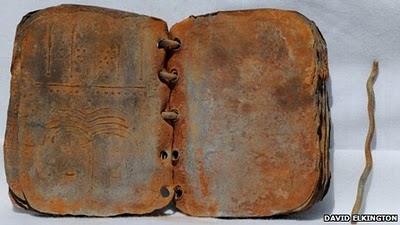
frFROM THE CHRISTIAN SCIENCE MONITOR
Could new discovery trump Dead Sea Scrolls? Scholars intrigued but cautious.
An Egyptologist has announced the discovery of 70 metal books in Jordan that he claims could be some of the oldest known Christian documents. But some evidence contradicts those claims.
Experts are responding with a mixture of caution, hope, and skepticism to new claims that a recently discovered trove of 70 ancient sealed books may represent some of the earliest Christian documents.
Written on lead in Hebrew and Aramaic, the secretly coded books – or codices – were hidden for centuries in a remote Jordanian cave until a traveling Bedouin found them some five years ago, according to a statement released last week by British Egyptologist David Elkington. Depictions of crosses on the lead-bound leaves, coupled with metallurgical analysis, suggest to Mr. Elkington that these might be early Christian texts that pre-date even some letters in the New Testament.
Others aren’t so sure. All evidence to date suggests Christians didn’t use the cross as a symbol until the 4th century, according to Hershel Shanks, editor of Biblical Archaeology Review. The use of codices also dates to a later period, he said, and metal analysis has yielded no precise dating in this case.
We have no fact about these that would indicate that they are Christian and date from this [mid-first century] period, except for some vague metallurgists who say they ‘could,’ ” Mr. Shanks says. “On the contrary, we have a number of things – the cross, the codex, [and other symbols] that counter this claim.”
New Testament scholar Craig Evans also hesitates to assume much about the early codices. They could be very significant, he said, if they really do trace to an early Jewish group that regarded Jesus as Messiah. That’s because most of what’s known about first-century communities comes either from Paul’s scriptural letters to Gentile churches, or from the Dead Sea Scrolls, which convey the traditional Jewish beliefs of first-century Essenes. Early Jewish Christians, as Evans calls those with Messianic beliefs, remain less well understood.
But “that’s a big if,” says Mr. Evans, a professor of New Testament at Acadia Divinity College in Wolfville, Nova Scotia. At this point, little is known about the content, purpose, or date of the codices. He says he’s hopeful that they’ll shed fresh light on Christian origins, but he’s not confident they will.
“To make claims right now about these being really early – ‘middle of the first century,’ or ‘earliest Christian writings’ – that’s a bit reckless,” Evans says.
Several factors are keeping the codices cloaked in mystery, at least for now. The fact that they’re written in code means scholars will need to crack the code before deciphering what’s said on the lead pages. And getting access to the texts could be difficult.
They’re reportedly in the possession of an Israeli Bedouin who claims they’ve been in his family for more than 100 years. Elkington’s team disputes that story, alleging instead that the codices were illegally smuggled out of Jordan after their recent discovery in a cave.
The Kingdom of Jordan is reportedly working to recover the codices under a law that gives the state ownership of newly discovered antiquities. Meanwhile, Elkington has announced that a book and documentary film are in the works.
“There is likely to be considerable academic and political debate about the collection’s authenticity, meaning, and interpretation,” said a March 22 news release from David and Jennifer Elkington. “But now there is also a race against time to safeguard the collection’s future.”
as many of the scholars above point out, several aspects of these codices beg skepticism. The stories regarding their discovery differ in critical areas. The descriptions of the hoard differ. The codices are written in “secret code.” The codices’ main protagonist is shortly publishing a book about them and doesn’t seem to have any real credentials in the fields in which he claims specialization (and he calls the last book of the New Testament “the book of Revelations”). The most significant issue with the codices is described in an email exchange circulated recently by a young Oxford scholar named Peter Thonemann (available here). In that email, Thonemann explains that late last year Elkington sent photos of a copper codex with Greek writing on it to him for analysis. Thonemann quickly discovered a link between the codex’s inscription and a Greek/Aramaic tombstone inscription on display in a museum in Jordan (and published in two places). The copper codex, however, conflates the lambda and the alpha in the majuscule script, indicating the person writing it didn’t recognize the small difference between the two. The second and fourth letters on the third line of the following text (from left to right) are majuscule lambdas and alphas, respectively. While the difference is pretty clear, in some hands it’s barely perceptible, especially in inscriptions on stone:
Now on to the copper codex:
This reads ΛΛΥΠΕΧΛΙΡΕΛΒΓΛΡΟΚΛΙΕΙΣΙΩΝ and then ΛΛΥΠΕ written backwards. Another plate has the following at the bottom:
This contains the following portion of the other inscription: ΛΥΠΕΧΛΙΡΕΛΒΓ. The inscription Thonemann points to reads thus, with the words written in minuscule script and separated by spaces:
1 Σελαμαν χρηστὲ καὶ
2 ἄλυπε χαῖρε, Ἀβγαρ ὁ καὶ Εἰσίων
3 Μονοαθου υἱὸς υἱῷ τειμίῳ τὸ μνῆμα
4 ἐποίησεν ἔτους τρίτου ἐπαρχείας
1 For Selaman, excellent and
2 harmless man, farewell! Abgar, also known as Eision,
3 son of Monoathos, for his excellent son, this tomb,
4 he constructed, in the third year of the province
Now here is the same inscription with portions from the first and then second inscriptions above bracketed:
1 Σελαμαν χρηστὲ καὶ
2 [ἄλυπε χαῖρε, Ἀβγαρ ὁ καὶ Εἰσίων]
3 Μονοαθου υἱὸς υἱῷ τειμίῳ τὸ μνῆμα
4 ἐποίησεν ἔτους τρίτου ἐπαρχείας
1 Σελαμαν χρηστὲ καὶ
2 ἄ[λυπε χαῖρε, Ἀβγ]αρ ὁ καὶ Εἰσίων
3 Μονοαθου υἱὸς υἱῷ τειμίῳ τὸ μνῆμα
4 ἐποίησεν ἔτους τρίτου ἐπαρχείας
The bracketed portions make no sense out of the context of the rest of the inscription. It seems the person responsible for the copper plate copied the entire second line off the inscription and then used portions of it on other plates. This indicates the copper codices are modern forgeries.
There are aspects of the copper plates which show they share the same provenance as the copper plate. Elkington seems to have overlooked this in sharing select photos of the lead codices. As I show in this post, the stylized palm tree near the bottom of the copper codex is exactly identical to a stylized tree that appears in at least one of the lead codices currently being publicized. This leads unquestionably to the conclusion that at least some of the lead codices come from the same forger who produced the copper codex. Other iconographic qualities are shared by other plates. Consider, for instance, this rectangular patterning from the copper codices:
Now take a look at some of the photos from the BBC set:
Now look at the star patterns under the palm tree in the copper codex:
Now look at the stars around the Menorah on some of the first photos released:
You can see both phenomena, as well as the stylized paleo-Hebrew on the forged copper plate and on the bigger plate:
The above also shows the codices were cast. The two-and-a-half registers on this plate are identical in every detail. The same set of images was pressed into clay three different times for a mold. The bottom half of the top register has been smoothed out to allow for the register below, showing it wasn’t stamped.
The dotted borders and their teardrop shaped adornments on this forged plate are also remarkably similar to the same phenomena on the “Jesus portrait” codex:
Notice also the same cryptic script, which looks like stylized, and sometimes reversed, paleo-Hebrew (see here for a brief judgment by an expert). The casting looks identical too. Bill Hamblin has also shown the Jesus portrait on this plate is strikingly similar to the image on ancient Helios coins. The copper plate also seems to have an impression of an old Alexander the Great coin with the lion headdress, which Hamblin discusses. These plates are all the work of the same hand, and the copper plate shows that that hand is the hand of a forger.
Some have posited that it’s still possible that some plates are authentic. Perhaps the copper plate was simply copied from authentic ones. While it’s certainly not totally outside the realm of possibility, a number of considerations mitigate the plausibility. First, it strains credulity to think that someone with authentic ancient codices would decide to go through the time and effort of producing fake ones to supplement the hoard, and then only publicize the fake codices. Second, we’ve seen no indication any plates have different origins. The notion that any are original is nothing more than wishful thinking. David Elkington’s credibility has been severely undermined by the fact that he hasn’t come froward on his own about Thonemann’s find, and is sharing photos of other codices that are clearly related to the copper ones. His story also changes with each new article.
Additionally, he is omitting from the publicity photos those qualities which pointed to forgery for Thonemann. No Greek writing is being shown. In fact, few of the photos show any kind of writing at all, unlike the earlier photos, and those that do show a much, much more cryptic script, perhaps intended to avoid the kind of embarrassing incident that happened with Thonemann? The changes in the collection also seem to indicate someone altered the plates after Thonemann’s analysis. Is Elkington in on the forgery? He doesn’t appear to be an innocent middleman who believes the codices to be authentic. He didn’t raise a stink when Thonemann told him his copper codex was bogus. Does Elkington stand to profit from the plates? Elkington doesn’t want to sell them, and is playing up that point. If he tried to sell them they could very easily be discovered as fake. However, he does have a book that may soon come out. He’s apparently been trying unsuccessfully to find a publisher. What better publicity could he produce by throwing the media a bone like this? if he’s just trying to sell books, the codices never have to see the light of day. In fact, the more intrigue and mystery he can produce, the more books he can sell. Is it a coincidence that we’re suddenly being told by the Telegraph that he’s been shot at by some Indiana Jones-like brotherhood trying to protect the codices from the world.
In light of these considerations, the burden of proof must lie exclusively with those who wish to assert any of these plates are authentic, and until some scientific analysis can show anything ancient is connected with these plates, I see no reason to give the question of their authenticity a second glance.
UPDATE: A gallery of all the photos released of the lead codices can be found here
http://danielomcclellan.wordpress.com/2011/04/03/thoughts-on-the-jordan-lead-codices/
JESUS BROTHER JAMES
Jesus of Nazareth (![]() /ˈdʒiːzəs/;
7–2 BC/BCE to 30–36 AD/CE), commonly referred to as Jesus Christ or
simply as Jesus or Christ, is the central figure of
Christianity. Most
Christian denominations venerate him as
God the
Son
incarnated and believe that he
rose from the dead after being
crucified.[13][14]
The principal sources of information regarding Jesus are the four
canonical gospels,[15]
which most
biblical scholars find useful for reconstructing Jesus' life and teachings.[16][17][18][19]
Scholars have correlated the
New
Testament accounts with non-Christian historical records to arrive at an
estimated chronology for the major episodes in the life of Jesus.[20][6][4][21]
/ˈdʒiːzəs/;
7–2 BC/BCE to 30–36 AD/CE), commonly referred to as Jesus Christ or
simply as Jesus or Christ, is the central figure of
Christianity. Most
Christian denominations venerate him as
God the
Son
incarnated and believe that he
rose from the dead after being
crucified.[13][14]
The principal sources of information regarding Jesus are the four
canonical gospels,[15]
which most
biblical scholars find useful for reconstructing Jesus' life and teachings.[16][17][18][19]
Scholars have correlated the
New
Testament accounts with non-Christian historical records to arrive at an
estimated chronology for the major episodes in the life of Jesus.[20][6][4][21]
Most critical historians agree that Jesus was a Galilean Jewish Rabbi who was regarded as a teacher and healer in Judaea,[22] that he was baptized by John the Baptist, and that he was crucified in Jerusalem on the orders of the Roman Prefect, Pontius Pilate, on the charge of sedition against the Roman Empire.[23] Critical Biblical scholars and historians have offered competing descriptions of Jesus as a self-described Messiah, as the leader of an apocalyptic movement, as an itinerant sage, as a charismatic healer, and as the founder of an independent religious movement. Most contemporary scholars of the historical Jesus consider him to have been an independent, charismatic founder of a Jewish restoration movement, anticipating a future apocalypse.[24] Other prominent scholars, however, contend that Jesus' "Kingdom of God" meant radical personal and social transformation instead of a future apocalypse.[24]
Christians traditionally believe that Jesus was born of a virgin, performed miracles, founded the Church, died sacrificially to achieve atonement, rose from the dead, and ascended into heaven, from which he will return.[14] The majority of Christians worship Jesus as the incarnation of God the Son, and "the Second Person of the Blessed Trinity".[25] A few Christian groups, however, reject Trinitarianism, wholly or partly, believing it to be non-scriptural.[25][26] Most Christian scholars today present Jesus as the awaited Messiah promised in the Old Testament and as God,[27] arguing that he fulfilled many Messianic prophecies of the Old Testament.[28]
Judaism rejects assertions that Jesus was the awaited Messiah, arguing that he did not fulfill the Messianic prophecies in the Tanakh.[29] In Islam, Jesus (in Arabic: عيسى in Islamic usage, commonly transliterated as Isa) is considered one of God's important prophets,[30][31] a bringer of scripture and the product of a virgin birth, but not the victim of crucifixion.[32] Islam and the Bahá'í Faith use the title "Messiah" for Jesus,[33][34] but do not teach that he was God incarnate.
In Matthew 26:36-46, Mark 14:32-42, Luke 22:39-46 and John 18:1, immediately after the Last Supper, Jesus takes a walk to pray, Matthew and Mark identifying this place of prayer as Garden of Gethsemane.[274][275]
Jesus is accompanied by Peter, John and James the Greater, whom he asks to "remain here and keep watch with me." He moves "a stone's throw away" from them, where he feels overwhelming sadness and says "My Father, if it is possible, let this cup pass me by. Nevertheless, let it be as you, not I, would have it."[275] Only the Gospel of Luke mentions the details of the sweat of blood of Jesus and the visitation of the angel who comforts Jesus as he accepts the will of the Father. Returning to the disciples after prayer, he finds them asleep and in Matthew 26:40 he asks Peter: "So, could you men not keep watch with me for an hour?"[275]
While in the Garden, Judas appears, accompanied by a crowd that includes the Jewish priests and elders and people with weapons. Judas gives Jesus a kiss to identify him to the crowd who then arrests Jesus.[275][276] One of Jesus' disciples tries to stop them and uses a sword to cut off the ear of one of the men in the crowd.[275][276] Luke states that Jesus miraculously healed the wound and John and Matthew state that Jesus criticized the violent act, insisting that his disciples should not resist his arrest. In Matthew 26:52 Jesus makes the well known statement: all who live by the sword, shall die by the sword.[275][276]
Prior to the arrest, in Matthew 26:31 Jesus tells the disciples: "All ye shall be offended in me this night" and in 32 that: "But after I am raised up, I will go before you into Galilee." After his arrest, Jesus' disciples go into hiding.[275]
THERE WERE MORE THAN ONE JAMES WORKING WITH JESUS, JAMES THE GREATER, JAMES THE LESER, JAMES THE JUST, AND JAMES THE THRONE OHLDER.
JAMES THE THRONE HOLDER IS THE ONE WE WANT TO LOOK AKT:
James: A brother and bond servant.
His didactic [a distinct message, using content over style or artistic form] booklet is usually referred to as one of the general or universal Epistles because it is written to the entire Church, unlike those of the Apostle Paul, who specifically directs his letters to individuals or groups of individuals; these are known as “Pauline Epistles.”
A question that comes up immediately is which James is mentioned in the New Testament who actually penned this letter?
There is James the Son of Zebedee, who was slain by Herod, recorded in Acts 12:1-2. About that time King Herod Agrippa began to persecute some believers in the church. [2] He had the apostle James (John's brother) killed with a sword. [NLT]
Then there is James the son of Alphaeus, who is called in Mark 15:40 James the less; mikros, mik-ros'; small:- least, less, little. The New Living Translation translates “micros” as our word younger. . . . Mary Magdalene, Mary (the mother of James the younger and of Joseph), and Salome. [NLT] Little else is known about this fellow James, so it would be appropriate to dismiss him as the author of such an important book.
Which brings us to James, our Lord’s brother; a son of Mary and Joseph. For those who were raised Catholic, this statement may prove troubling, however, Matthew 13:53-56 should remove any doubt about this relationship.
[53] And it came about that when Jesus had finished these parables, He departed from there. [54] And coming to His home town He began teaching them in their synagogue, so that they became astonished, and said, "Where did this man get this wisdom, and these miraculous powers? [55] "Is not this the carpenter's son? Is not His mother called Mary, and His brothers, James and Joseph and Simon and Judas? [56] "And His sisters, are they not all with us? Where then did this man get all these things?" [NASB]
Although, in the beginning Jesus’ brothers did not believe Him to be anything other their brother. Yet, as time passed following the resurrection and the coming of the Spirit, Acts 15 finds James apparently in a position of Church leadership, presiding over the great council in Jerusalem. Paul makes reference to this in Galatians 2:9 In fact, James, Peter, and John, who were known as pillars of the church, recognized the gift God had given me, and they accepted Barnabas and me as their co-workers. They encouraged us to keep preaching to the Gentiles, while they continued their work with the Jews. [NLT]
James, Brother of JesusBy Roger A. RushJames, like the Lord's other siblings, was not supportive of Jesus during his early ministry. The apostle John makes the point that even his own brothers did not believe in him (John 7:5). However, that was to change. Among those disciples who were found with the apostles in Jerusalem following the Lord's ascension were his brothers, which obviously included James, who was to later play a prominent role in the Jerusalem church (Acts 1:14). According to Paul, an inspired apostle, Jesus appeared to James following his resurrection (1 Corinthians 15:7). Jerome, a fourth century Christian author, records a legend which says that James had made a vow to not eat or drink until he had seen Jesus raised from the dead. Supposedly, Jesus appeared to James and said, "My brother, eat thy bread, for the Son of man is risen from the dead" (F. W. Farrar, The Pulpit Commentary, Grand Rapids: Wm. B. Eerdmans Publishing Company, 1950, Vol. 19, p. 484). As already noted, before the crucifixion, his brothers were unbelievers. It was the resurrection of Jesus which brought them to faith. James became a leading figure in the church at Jerusalem. When Peter was released from prison he came to the house of Mary where many in the church had come together to pray for him (Acts 12:12). According to Peter's account of that evening, the Lord had instructed him to tell James and the brethren of his prison escape, which Peter then did (Acts 12:17). When the controversy arose over certain Judaizers who were demanding the circumcision of Gentle Christians, Paul and Barnabas met in Jerusalem with the apostles and elders, and James played a significant role in that meeting (Acts 15:13-21). It was James who reminded them of Peter's encounter with Cornelius and how the Gentiles were to be brought into the kingdom. He further argued that this was in agreement with what the prophets had predicted. He then recommended they write a letter to Gentile churches in which they would be told to "abstain from pollutions of idols, and from fornication, and from things strangled, and from blood" (Acts 15:20). The apostles, elders and the whole church agreed, and it was done. Following Paul's third missionary tour, he returned to Jerusalem. One day after his arrival in the city he reported to James and the elders what God had accomplished through him among the Gentiles (Acts 21:18-25). It is not surprising that James is again singled out among those in the church at Jerusalem. It was Paul who referred to James, along with Peter and John, as pillars in the church who had extended to him and Barnabas the right hand of fellowship, and encouraged their work among the Gentiles (Galatians 2:9-10). But, it is for the New Testament epistle which bears his name that James is most remembered. This epistle offered such a devastating blow to the doctrine of salvation by faith only or alone that Martin Luther refused to accept it as canonical, and referred to it as "right strawy" and thus of no value. Paul had written that Abraham was justified by faith (Romans 3:28). James asserted that Abraham was justified by works (James 2:23-24). But, the passages were not contradictory as Luther believed. Rather, they were complementary. Together they underscored the necessity of a living faith which always produces active obedience. This idea is plainly set forth in Hebrews 11 where believers were commended for demonstrating faith through action or deeds. Abel's faith produced an acceptable sacrifice. Enoch's faith led to a walk with God. Noah's faith built an ark. Abraham's faith caused him to pack up and move at God's bidding, and, ultimately led him to the point where, at God's command, he was prepared to offer his son, Isaac. Both Paul and James understood the relationship between faith and works (obedience) in regard to man's relationship with God. Luther, however, did not! Other themes which James touched upon in his epistle included the nature of temptation and its source (1:2-18); pure religion (1:19-27); the dangers of the tongue (3:1-12); true and false wisdom (3:13-18); the source of discord among brethren (4:1-10); the future and how to face it (4:11-17); the dangers of wealth (5:1-6); and patience, prayer and confession (5:7-20). Addressed to the twelve tribes of the dispersion, it was among the most practical epistles of the New Testament. According to Josephus, the high priest, Ananus (his father was also called Ananus), a man bold in temperament and very indolent, convened the judges of the Sanhedrin and brought before them a man called James, the brother of Jesus who was called the Christ, and certain others. He accused them of having transgressed the law and delivered them up to be stoned (Flavius Josephus, Antiquities of the Jews, page 598). Hegesippus, a second century writer, says that James was thrown down from the pinnacle of the temple, stoned, and finally killed by a fuller's club (Jack P. Lewis, Historical Backgrounds of Bible History, page 141). Ot os a;sp saod otjat je brple bptj ;egs/ Although at first unwilling to accept Jesus as the
Son of God, James came to be a staunch believer and a respected leader
in the early church. Ultimately, he died for his faith. |
The following article is excerpted from the International Standard Bible Encyclopedia, which is in the public domain.
This James is mentioned by name only twice in the Gospels, i.e. when, on the visit of Jesus to Nazareth, the countrymen of our Lord referred in contemptuous terms to His earthly kindred, in order to disparage His preaching (Matthew 13:55; Mark 6:3). As James was one of "his brethren," he was probably among the group of Christ's relatives who sought to interview Him during His tour through Galilee with the Twelve (Matthew 12:46). By the same reasoning, he accompanied Jesus on His journey to Capernaum (John 2:12), and joined in attempting to persuade Him to depart from Galilee for Judea on the eve of the Feast of Tabernacles (John 7:3). At this feast James was present (John 7:10), but was at this time a non-believer in Jesus (compare John 7:5, "Even his brethren did not believe on him").
In the Epistles
Yet the seeds of conversion were being sown within him, for, after the crucifixion, he remained in Jerusalem with his mother and brethren, and formed one of that earliest band of believers who "with one accord continued stedfastly in prayer" (Acts 1:14). While there, he probably took part in the election of Matthias to the vacant apostleship (Acts 1:15-25). James was one of the earliest witnesses to the resurrection, for, after the risen Lord had manifested Himself to the five hundred, "he was seen of James" (1 Corinthians 15:7 the King James Version). By this his growing belief and prayerful expectancy received confirmation. About 37 or 38 AD, James, "the Lord's brother" (Galatians 1:19), was still in Jerusalem, and had an interview there for the first time with Paul, when the latter returned from his 3 years' sojourn in Damascus to visit Cephas, or Peter (Galatians 1:18,19; compare Acts 9:26). In several other passages the name of James is coupled with that of Peter. Thus, when Peter escaped from prison (about 44 AD), he gave instructions to those in the house of John Mark that they should immediately inform "James and the brethren" of the manner of his escape (Acts 12:17).
By the time of the Jerusalem convention, i.e. about 51 AD (compare Galatians 2:1), James had reached the position of first overseer in the church (compare Acts 15:13,19). Previous to this date, during Paul's ministry at Antioch, he had dispatched certain men thither to further the mission, and the teaching of these had caused dissension among the newly converted Christians and their leaders (Acts 15:1,2; Galatians 2:12). The conduct of Peter, over whom James seems to have had considerable influence, was the principal matter of contention (compare Galatians 2:11 if). However, at the Jerusalem convention the dispute was amicably settled, and the pillars of the church, James, John and Cephas, gave to Paul and Barnabas the right hand of fellowship (Galatians 2:9).
The speech of James on this occasion (Acts 15:13-29), his sympathy with the religious needs of the Gentileworld (Acts 15:17), his desire that formalism should raise no barrier to their moral and spiritual advancement (Acts 15:19,20,28,29), and his large-hearted tributes to the "beloved Barnabas and Paul" (Acts 15:25,26), indicate that James was a leader in whom the church was blessed, a leader who loved peace more than faction, the spirit more than the law, and who perceived that religious communities with different forms of observance might still live and work together in common allegiance to Christ. Once more (58 AD), James was head of the council at Jerusalem when Paul made report of his labors, this time of his 3rd missionary Journey (Acts 21:17).
At this meeting Paul was admonished for exceeding the orders he had received at the first council, in that he had endeavored to persuade the converted Jews also to neglect circumcision (Acts 21:21), and was commanded to join in the vow of purification (Acts 21:23-26). There is no Scriptural account of the death of James From 1 Corinthians 9:5 it has been inferred that he was married. This is, however, only a conjecture, as the passage refers to those who "lead about a sister, a wife" (the King James Version), while, so far as we know, James remained throughout his life in Jerusalem. This James has been regarded as the author of the Epistle of James, "a servant of God and of the Lord Jesus Christ ."
References in Apocryphal Literature
James figures in one of the miraculous events recorded in the Gnostic "Gospel of the Infancy, by Thomas the Israelite philosopher," being cured of a snake-bite by the infant Jesus (compare Hennecke, Handbuch zu den neutestamentlichen Apokryphen, 73). According to the Gospel of the Hebrews (compare ib, 11-21), James had also partaken of the cup of the Lord, and refused to eat till he had seen the risen Lord. Christ acknowledged this tribute by appearing to James first. In the Ac of Peter (compare Budge, Contendings of the Apostles, II, 475), it is stated that "three days after the ascension of our Lord into heaven, James, whom our Lord called his `brother in the flesh,' consecrated the Offering and we all drew nigh to partake thereof: and when ten days had passed after the ascension of our Lord, we all assembled in the holy fortress of Zion, and we stood up to say the prayer of sanctification, and we made supplication unto God and besought Him with humility, and James also entreated Him concerning the descent of the Holy Ghost upon the Offering."
The Preaching of James the Just (compare Budge, II, 78-81) tells of the appointment of James to the bishopric of Jerusalem, of his preaching, healing of the sick and casting out of devils there. This is confirmed by the evidence of Clement of Alexandria (Euseb., HE, II, 1). In the Martyrdom of James the Just (compare Budge, II, 82-89), it is stated that J., "the youngest of the sons of Joseph," alienated, by his preaching, Piobsata from her husband Ananus, the governor of Jerusalem. Ananus therefore inflamed the Jews against James, and they hurled him down from off the pinnacle of the temple. Hegesippus, quoted by Eusebius (Historia Ecclesiastica, II, 23), and Josephus (Ant., XX, ix, 1), testify to the general truth of this. It is thus probable that James was martyred about 62 or 63 AD. Besides the epistle which bears his name, James was also the reputed author of the Protevangelium Jacobi, a work which originated in the 2nd century and received later additions
C. M. Kerr
International Standard Bible Encyclopedia
The Protoevangelium of James
The Birth of Mary the Holy Mother of God, and Very Glorious Mother of Jesus Christ.
1. In the records of the twelve tribes of Israel was Joachim, a man rich exceedingly; and he brought his offerings double, saying: There shall be of my superabundance to all the people, and there shall be the offering for my forgiveness to the Lord for a propitiation for me. For the great day of the Lord was at hand, and the sons of Israel were bringing their offerings. And there stood over against him Rubim, saying: It is not meet for you first to bring your offerings, because you have not made seed in Israel. And Joachim was exceedingly grieved, and went away to the registers of the twelve tribes of the people, saying: I shall see the registers of the twelve tribes of Israel, as to whether I alone have not made seed in Israel. And he searched, and found that all the righteous had raised up seed in Israel. And he called to mind the patriarch Abraham, that in the last day God gave him a son Isaac. And Joachim was exceedingly grieved, and did not come into the presence of his wife; but he retired to the desert, and there pitched his tent, and fasted forty days and forty nights, saying in himself: I will not go down either for food or for drink until the Lord my God shall look upon me, and prayer shall be my food and drink.
2. And his wife Anna mourned in two mournings, and lamented in two lamentations, saying: I shall bewail my widowhood; I shall bewail my childlessness. And the great day of the Lord was at hand; and Judith her maid-servant said: How long do you humiliate your soul? Behold, the great day of the Lord is at hand, and it is unlawful for you to mourn. But take this head-band, which the woman that made it gave to me; for it is not proper that I should wear it, because I am a maid-servant, and it has a royal appearance. And Anna said: Depart from me; for I have not done such things, and the Lord has brought me very low. I fear that some wicked person has given it to you, and you have come to make me a sharer in your sin. And Judith said: Why should I curse you, seeing that the Lord has shut your womb, so as not to give you fruit in Israel? And Anna was grieved exceedingly, and put off her garments of mourning, and cleaned her head, and put on her wedding garments, and about the ninth hour went down to the garden to walk. And she saw a laurel, and sat under it, and prayed to the Lord, saying: O God of our fathers, bless me and hear my prayer, as You blessed the womb of Sarah, and gave her a son Isaac.
3. And gazing towards the heaven, she saw a sparrow's nest in the laurel, Tobit 2:10 and made a lamentation in herself, saying: Alas! Who begot me? And what womb produced me? Because I have become a curse in the presence of the sons of Israel, and I have been reproached, and they have driven me in derision out of the temple of the Lord. Alas! To what have I been likened? I am not like the fowls of the heaven, because even the fowls of the heaven are productive before You, O Lord. Alas! To what have I been likened? I am not like the beasts of the earth, because even the beasts of the earth are productive before You, O Lord. Alas! To what have I been likened? I am not like these waters, because even these waters are productive before You, O Lord. Alas! To what have I been likened? I am not like this earth, because even the earth brings forth its fruits in season, and blesses You, O Lord.
4. And, behold, an angel of the Lord stood by, saying: Anna, Anna, the Lord has heard your prayer, and you shall conceive, and shall bring forth; and your seed shall be spoken of in all the world. And Anna said: As the Lord my God lives, if I beget either male or female, I will bring it as a gift to the Lord my God; and it shall minister to Him in holy things all the days of its life. 1 Samuel 1:11 And, behold, two angels came, saying to her: Behold, Joachim your husband is coming with his flocks. For an angel of the Lord went down to him, saying: Joachim, Joachim, the Lord God has heard your prayer. Go down hence; for, behold, your wife Anna shall conceive. And Joachim went down and called his shepherds, saying: Bring me hither ten she-lambs without spot or blemish, and they shall be for the Lord my God; and bring me twelve tender calves, and they shall be for the priests and the elders; and a hundred goats for all the people. And, behold, Joachim came with his flocks; and Anna stood by the gate, and saw Joachim coming, and she ran and hung upon his neck, saying: Now I know that the Lord God has blessed me exceedingly; for, behold the widow no longer a widow, and I the childless shall conceive. And Joachim rested the first day in his house.
5. And on the following day he brought his offerings, saying in himself: If the Lord God has been rendered gracious to me, the plate on the priest's forehead will make it manifest to me. And Joachim brought his offerings, and observed attentively the priest's plate when he went up to the altar of the Lord, and he saw no sin in himself. And Joachim said: Now I know that the Lord has been gracious unto me, and has remitted all my sins. And he went down from the temple of the Lord justified, and departed to his own house. And her months were fulfilled, and in the ninth month Anna brought forth. And she said to the midwife: What have I brought forth? And she said: A girl. And said Anna: My soul has been magnified this day. And she laid her down. And the days having been fulfilled, Anna was purified, and gave the breast to the child, and called her name Mary.
6. And the child grew strong day by day; and when she was six months old, her mother set her on the ground to try whether she could stand, and she walked seven steps and came into her bosom; and she snatched her up, saying: As the Lord my God lives, you shall not walk on this earth until I bring you into the temple of the Lord. And she made a sanctuary in her bed-chamber, and allowed nothing common or unclean to pass through her. And she called the undefiled daughters of the Hebrews, and they led her astray. And when she was a year old, Joachim made a great feast, and invited the priests, and the scribes, and the elders, and all the people of Israel. And Joachim brought the child to the priests; and they blessed her, saying: O God of our fathers, bless this child, and give her an everlasting name to be named in all generations. And all the people said: So be it, so be it, amen. And he brought her to the chief priests; and they blessed her, saying: O God most high, look upon this child, and bless her with the utmost blessing, which shall be for ever. And her mother snatched her up, and took her into the sanctuary of her bed-chamber, and gave her the breast. And Anna made a song to the Lord God, saying: I will sing a song to the Lord my God, for He has looked upon me, and has taken away the reproach of mine enemies; and the Lord has given the fruit of His righteousness, singular in its kind, and richly endowed before Him. Who will tell the sons of Rubim that Anna gives suck? Hear, hear, you twelve tribes of Israel, that Anna gives suck. And she laid her to rest in the bed-chamber of her sanctuary, and went out and ministered unto them. And when the supper was ended, they went down rejoicing, and glorifying the God of Israel.
7. And her months were added to the child. And the child was two years old, and Joachim said: Let us take her up to the temple of the Lord, that we may pay the vow that we have vowed, lest perchance the Lord send to us, and our offering be not received. And Anna said: Let us wait for the third year, in order that the child may not seek for father or mother. And Joachim said: So let us wait. And the child was three years old, and Joachim said: Invite the daughters of the Hebrews that are undefiled, and let them take each a lamp, and let them stand with the lamps burning, that the child may not turn back, and her heart be captivated from the temple of the Lord. And they did so until they went up into the temple of the Lord. And the priest received her, and kissed her, and blessed her, saying: The Lord has magnified your name in all generations. In you, on the last of the days, the Lord will manifest His redemption to the sons of Israel. And he set her down upon the third step of the altar, and the Lord God sent grace upon her; and she danced with her feet, and all the house of Israel loved her.
8. And her parents went down marvelling, and praising the Lord God, because the child had not turned back. And Mary was in the temple of the Lord as if she were a dove that dwelt there, and she received food from the hand of an angel. And when she was twelve years old there was held a council of the priests, saying: Behold, Mary has reached the age of twelve years in the temple of the Lord. What then shall we do with her, lest perchance she defile the sanctuary of the Lord? And they said to the high priest: You stand by the altar of the Lord; go in, and pray concerning her; and whatever the Lord shall manifest unto you, that also will we do. And the high priest went in, taking the robe with the twelve bells into the holy of holies; and he prayed concerning her. And behold an angel of the Lord stood by him, saying unto him: Zacharias, Zacharias, go out and assemble the widowers of the people, and let them bring each his rod; and to whomsoever the Lord shall show a sign, his wife shall she be. And the heralds went out through all the circuit of Judæa, and the trumpet of the Lord sounded, and all ran.
9. And Joseph, throwing away his axe, went out to meet them; and when they had assembled, they went away to the high priest, taking with them their rods. And he, taking the rods of all of them, entered into the temple, and prayed; and having ended his prayer, he took the rods and came out, and gave them to them: but there was no sign in them, and Joseph took his rod last; and, behold, a dove came out of the rod, and flew upon Joseph's head. And the priest said to Joseph, You have been chosen by lot to take into your keeping the virgin of the Lord. But Joseph refused, saying: I have children, and I am an old man, and she is a young girl. I am afraid lest I become a laughing-stock to the sons of Israel. And the priest said to Joseph: Fear the Lord your God, and remember what the Lord did to Dathan, and Abiram, and Korah; Numbers 16:31-33 how the earth opened, and they were swallowed up on account of their contradiction. And now fear, O Joseph, lest the same things happen in your house. And Joseph was afraid, and took her into his keeping. And Joseph said to Mary: Behold, I have received you from the temple of the Lord; and now I leave you in my house, and go away to build my buildings, and I shall come to you. The Lord will protect you.
10. And there was a council of the priests, saying: Let us make a veil for the temple of the Lord. And the priest said: Call to me the undefiled virgins of the family of David. And the officers went away, and sought, and found seven virgins. And the priest remembered the child Mary, that she was of the family of David, and undefiled before God. And the officers went away and brought her. And they brought them into the temple of the Lord. And the priest said: Choose for me by lot who shall spin the gold, and the white, and the fine linen, and the silk, and the blue, and the scarlet, and the true purple. Exodus 25:4 And the true purple and the scarlet fell to the lot of Mary, and she took them, and went away to her house. And at that time Zacharias was dumb, and Samuel was in his place until the time that Zacharias spoke. And Mary took the scarlet, and span it.
11. And she took the pitcher, and went out to fill it with water. And, behold, a voice saying: Hail, you who hast received grace; the Lord is with you; blessed are you among women! Luke 1:28 And she looked round, on the right hand and on the left, to see whence this voice came. And she went away, trembling, to her house, and put down the pitcher; and taking the purple, she sat down on her seat, and drew it out. And, behold, an angel of the Lord stood before her, saying: Fear not, Mary; for you have found grace before the Lord of all, and you shall conceive, according to His word. And she hearing, reasoned with herself, saying: Shall I conceive by the Lord, the living God? And shall I bring forth as every woman brings forth? And the angel of the Lord said: Not so, Mary; for the power of the Lord shall overshadow you: wherefore also that holy thing which shall be born of you shall be called the Son of the Most High. And you shall call His name Jesus, for He shall save His people from their sins. And Mary said: Behold, the servant of the Lord before His face: let it be unto me according to your word.
12. And she made the purple and the scarlet, and took them to the priest. And the priest blessed her, and said: Mary, the Lord God has magnified your name, and you shall be blessed in all the generations of the earth. And Mary, with great joy, went away to Elizabeth her kinswoman, Luke 1:39-40 and knocked at the door. And when Elizabeth heard her, she threw away the scarlet, and ran to the door, and opened it; and seeing Mary, she blessed her, and said: Whence is this to me, that the mother of my Lord should come to me? For, behold, that which is in me leaped and blessed you. Luke 1:34, 44 But Mary had forgotten the mysteries of which the archangel Gabriel had spoken, and gazed up into heaven, and said: Who am I, O Lord, that all the generations of the earth should bless me? Luke 1:48 And she remained three months with Elizabeth; and day by day she grew bigger. And Mary being afraid, went away to her own house, and hid herself from the sons of Israel. And she was sixteen years old when these mysteries happened.
13. And she was in her sixth month; and, behold, Joseph came back from his building, and, entering into his house, he discovered that she was big with child. And he smote his face, and threw himself on the ground upon the sackcloth, and wept bitterly, saying: With what face shall I look upon the Lord my God? And what prayer shall I make about this maiden? Because I received her a virgin out of the temple of the Lord, and I have not watched over her. Who is it that has hunted me down? Who has done this evil thing in my house, and defiled the virgin? Has not the history of Adam been repeated in me? For just as Adam was in the hour of his singing praise, and the serpent came, and found Eve alone, and completely deceived her, so it has happened to me also. And Joseph stood up from the sackcloth, and called Mary, and said to her: O you who hast been cared for by God, why have you done this and forgotten the Lord your God? Why have you brought low your soul, you that wast brought up in the holy of holies, and that received food from the hand of an angel? And she wept bitterly, saying: I am innocent, and have known no man. And Joseph said to her: Whence then is that which is in your womb? And she said: As the Lord my God lives, I do not know whence it is to me.
14. And Joseph was greatly afraid, and retired from her, and considered what he should do in regard to her. Matthew 1:19 And Joseph said: If I conceal her sin, I find myself fighting against the law of the Lord; and if I expose her to the sons of Israel, I am afraid lest that which is in her be from an angel, and I shall be found giving up innocent blood to the doom of death. What then shall I do with her? I will put her away from me secretly. And night came upon him; and, behold, an angel of the Lord appears to him in a dream, saying: Be not afraid for this maiden, for that which is in her is of the Holy Spirit; and she will bring forth a Son, and you shall call His name Jesus, for He will save His people from their sins. Matthew 1:20 And Joseph arose from sleep, and glorified the God of Israel, who had given him this grace; and he kept her.
15. And Annas the scribe came to him, and said: Why have you not appeared in our assembly? And Joseph said to him: Because I was weary from my journey, and rested the first day. And he turned, and saw that Mary was with child. And he ran away to the priest, and said to him: Joseph, whom you vouched for, has committed a grievous crime. And the priest said: How so? And he said: He has defiled the virgin whom he received out of the temple of the Lord, and has married her by stealth, and has not revealed it to the sons of Israel. And the priest answering, said: Has Joseph done this? Then said Annas the scribe: Send officers, and you will find the virgin with child. And the officers went away, and found it as he had said; and they brought her along with Joseph to the tribunal. And the priest said: Mary, why have you done this? And why have you brought your soul low, and forgotten the Lord your God? You that wast reared in the holy of holies, and that received food from the hand of an angel, and heard the hymns, and danced before Him, why have you done this? And she wept bitterly, saying: As the Lord my God lives, I am pure before Him, and know not a man. And the priest said to Joseph: Why have you done this? And Joseph said: As the Lord lives, I am pure concerning her. Then said the priest: Bear not false witness, but speak the truth. You have married her by stealth, and hast not revealed it to the sons of Israel, and hast not bowed your head under the strong hand, that your seed might be blessed. And Joseph was silent.
16. And the priest said: Give up the virgin whom you received out of the temple of the Lord. And Joseph burst into tears. And the priest said: I will give you to drink of the water of the ordeal of the Lord, and He shall make manifest your sins in your eyes. And the priest took the water, and gave Joseph to drink and sent him away to the hill-country; and he returned unhurt. And he gave to Mary also to drink, and sent her away to the hill-country; and she returned unhurt. And all the people wondered that sin did not appear in them. And the priest said: If the Lord God has not made manifest your sins, neither do I judge you. And he sent them away. And Joseph took Mary, and went away to his own house, rejoicing and glorifying the God of Israel.
17. And there was an order from the Emperor Augustus, that all in Bethlehem of Judæa should be enrolled. Luke 2:1 And Joseph said: I shall enrol my sons, but what shall I do with this maiden? How shall I enrol her? As my wife? I am ashamed. As my daughter then? But all the sons of Israel know that she is not my daughter. The day of the Lord shall itself bring it to pass as the Lord will. And he saddled the ass, and set her upon it; and his son led it, and Joseph followed. And when they had come within three miles, Joseph turned and saw her sorrowful; and he said to himself: Likely that which is in her distresses her. And again Joseph turned and saw her laughing. And he said to her: Mary, how is it that I see in your face at one time laughter, at another sorrow? And Mary said to Joseph: Because I see two peoples with my eyes; the one weeping and lamenting, and the other rejoicing and exulting. And they came into the middle of the road, and Mary said to him: Take me down from off the ass, for that which is in me presses to come forth. And he took her down from off the ass, and said to her: Whither shall I lead you, and cover your disgrace? For the place is desert.
18. And he found a cave there, and led her into it; and leaving his two sons beside her, he went out to seek a widwife in the district of Bethlehem.
And I Joseph was walking, and was not walking; and I looked up into the sky, and saw the sky astonished; and I looked up to the pole of the heavens, and saw it standing, and the birds of the air keeping still. And I looked down upon the earth, and saw a trough lying, and work-people reclining: and their hands were in the trough. And those that were eating did not eat, and those that were rising did not carry it up, and those that were conveying anything to their mouths did not convey it; but the faces of all were looking upwards. And I saw the sheep walking, and the sheep stood still; and the shepherd raised his hand to strike them, and his hand remained up. And I looked upon the current of the river, and I saw the mouths of the kids resting on the water and not drinking, and all things in a moment were driven from their course.
19. And I saw a woman coming down from the hill-country, and she said to me: O man, whither are you going? And I said: I am seeking an Hebrew midwife. And she answered and said unto me: Are you of Israel? And I said to her: Yes. And she said: And who is it that is bringing forth in the cave? And I said: A woman betrothed to me. And she said to me: Is she not your wife? And I said to her: It is Mary that was reared in the temple of the Lord, and I obtained her by lot as my wife. And yet she is not my wife, but has conceived of the Holy Spirit.
And the widwife said to him: Is this true? And Joseph said to her: Come and see. And the midwife went away with him. And they stood in the place of the cave, and behold a luminous cloud overshadowed the cave. And the midwife said: My soul has been magnified this day, because my eyes have seen strange things— because salvation has been brought forth to Israel. And immediately the cloud disappeared out of the cave, and a great light shone in the cave, so that the eyes could not bear it. And in a little that light gradually decreased, until the infant appeared, and went and took the breast from His mother Mary. And the midwife cried out, and said: This is a great day to me, because I have seen this strange sight. And the midwife went forth out of the cave, and Salome met her. And she said to her: Salome, Salome, I have a strange sight to relate to you: a virgin has brought forth— a thing which her nature admits not of. Then said Salome: As the Lord my God lives, unless I thrust in my finger, and search the parts, I will not believe that a virgin has brought forth.
20. And the midwife went in, and said to Mary: Show yourself; for no small controversy has arisen about you. And Salome put in her finger, and cried out, and said: Woe is me for mine iniquity and mine unbelief, because I have tempted the living God; and, behold, my hand is dropping off as if burned with fire. And she bent her knees before the Lord, saying: O God of my fathers, remember that I am the seed of Abraham, and Isaac, and Jacob; do not make a show of me to the sons of Israel, but restore me to the poor; for You know, O Lord, that in Your name I have performed my services, and that I have received my reward at Your hand. And, behold, an angel of the Lord stood by her, saying to her: Salome, Salome, the Lord has heard you. Put your hand to the infant, and carry it, and you will have safety and joy. And Salome went and carried it, saying: I will worship Him, because a great King has been born to Israel. And, behold, Salome was immediately cured, and she went forth out of the cave justified. And behold a voice saying: Salome, Salome, tell not the strange things you have seen, until the child has come into Jerusalem.
21. And, behold, Joseph was ready to go into Judæa. And there was a great commotion in Bethlehem of Judæa, for Magi came, saying: Where is he that is born king of the Jews? For we have seen his star in the east, and have come to worship him. And when Herod heard, he was much disturbed, and sent officers to the Magi. And he sent for the priests, and examined them, saying: How is it written about the Christ? Where is He to be born? And they said: In Bethlehem of Judæa, for so it is written. And he sent them away. And he examined the Magi, saying to them: What sign have you seen in reference to the king that has been born? And the Magi said: We have seen a star of great size shining among these stars, and obscuring their light, so that the stars did not appear; and we thus knew that a king has been born to Israel, and we have come to worship him. And Herod said: Go and seek him; and if you find him, let me know, in order that I also may go and worship him. And the Magi went out. And, behold, the star which they had seen in the east went before them until they came to the cave, and it stood over the top of the cave. And the Magi saw the infant with His mother Mary; and they brought forth from their bag gold, and frankincense, and myrrh. And having been warned by the angel not to go into Judæa, they went into their own country by another road.
22. And when Herod knew that he had been mocked by the Magi, in a rage he sent murderers, saying to them: Slay the children from two years old and under. And Mary, having heard that the children were being killed, was afraid, and took the infant and swaddled Him, and put Him into an ox-stall. And Elizabeth, having heard that they were searching for John, took him and went up into the hill-country, and kept looking where to conceal him. And there was no place of concealment. And Elizabeth, groaning with a loud voice, says: O mountain of God, receive mother and child. And immediately the mountain was cleft, and received her. And a light shone about them, for an angel of the Lord was with them, watching over them.
23. And Herod searched for John, and sent officers to Zacharias, saying: Where have you hid your son? And he, answering, said to them: I am the servant of God in holy things, and I sit constantly in the temple of the Lord: I do not know where my son is. And the officers went away, and reported all these things to Herod. And Herod was enraged, and said: His son is destined to be king over Israel. And he sent to him again, saying: Tell the truth; where is your son? For you know that your life is in my hand. And Zacharias said: I am God's martyr, if you shed my blood; for the Lord will receive my spirit, because you shed innocent blood at the vestibule of the temple of the Lord. And Zacharias was murdered about daybreak. And the sons of Israel did not know that he had been murdered.
24. But at the hour of the salutation the priests went away, and Zacharias did not come forth to meet them with a blessing, according to his custom. And the priests stood waiting for Zacharias to salute him at the prayer, and to glorify the Most High. And he still delaying, they were all afraid. But one of them ventured to go in, and he saw clotted blood beside the altar; and he heard a voice saying: Zacharias has been murdered, and his blood shall not be wiped up until his avenger come. And hearing this saying, he was afraid, and went out and told it to the priests. And they ventured in, and saw what had happened; and the fretwork of the temple made a wailing noise, and they rent their clothes from the top even to the bottom. And they found not his body, but they found his blood turned into stone. And they were afraid, and went out and reported to the people that Zacharias had been murdered. And all the tribes of the people heard, and mourned, and lamented for him three days and three nights. And after the three days, the priests consulted as to whom they should put in his place; and the lot fell upon Simeon. For it was he who had been warned by the Holy Spirit that he should not see death until he should see the Christ in the flesh.
And I James that wrote this history in Jerusalem, a commotion having arisen when Herod died, withdrew myself to the wilderness until the commotion in Jerusalem ceased, glorifying the Lord God, who had given me the gift and the wisdom to write this history. And grace shall be with them that fear our Lord Jesus Christ, to whom be glory to ages of ages. Amen.
MORE TO COME AS THE LEAD BOOKS ARE TRANSCRIBED
THIS BLOG CONTIINUES ON PAGE 89
http://www.earthmountainview.coom
